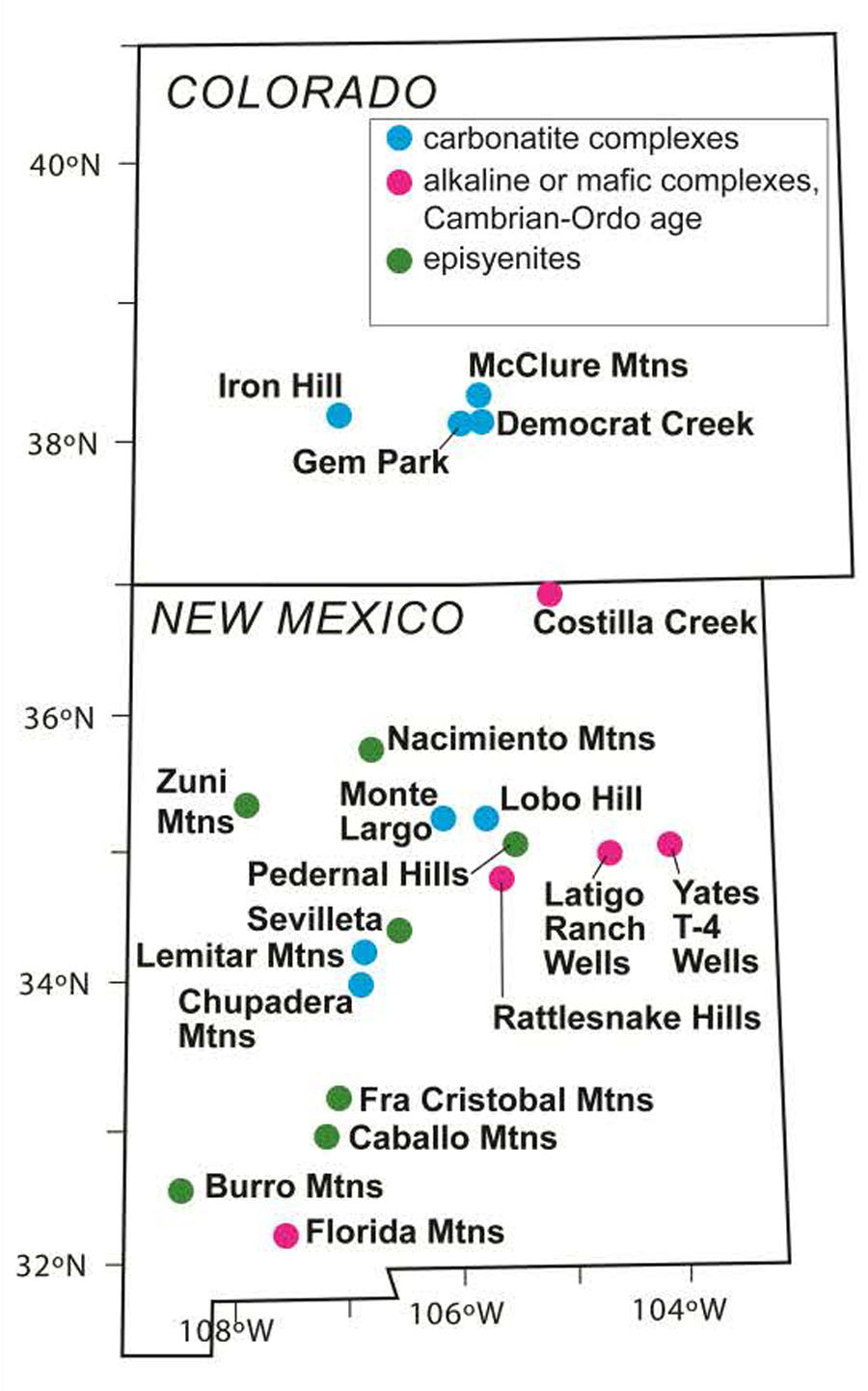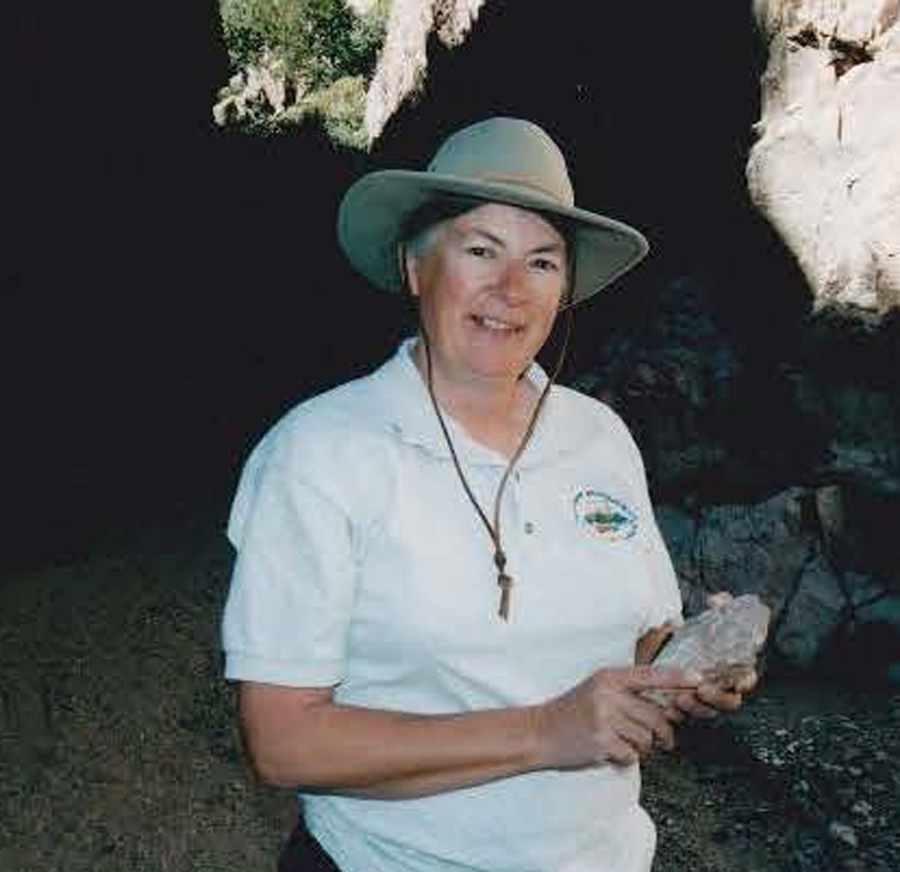Arizona Geological Society
2023 Speaker Series
Thursday, September 7, 2023 | 6:30 - 7:30 PM
ZOOM Link – https://arizona.zoom.us/j/89006049062
Please mute yourself during the presentation
--- No registration required -
Rare earth element (REE) potential and origin of the Cambrian-Ordovician carbonatites and episyenites
in southern New Mexico
by Virginia T. McLemore,
New Mexico Bureau of Geology and Mineral Resources
New Mexico Tech, Socorro, New Mexico 87801
Abstract: A widespread Cambrian-Ordovician alkaline magmatic event occurred throughout New Mexico and southern Colorado (McMillan and McLemore, 2001) and is evidenced by the intrusion of carbonatites, syenites, monzonites, and alkaline granites and associated K-metasomatism (i.e. fenites and episyenites). Episyenites found in the Caballo, Burro, and Zuni Mountains are brick-red, K-feldspar-rich rocks formed by desilicification and metasomatism of granites by alkali-rich fluids, possibly related to alkaline or carbonatite magmas. The episyenites were originally interpreted to be igneous, but based on recent mapping and geochemical analysis, are actually metasomatic in origin. Field observations and mapping indicate that these episyenites are typically found as flat-lying pods or lenses (<300 m in diameter), pipe-like bodies, and dike-like bodies (<2 m wide, 400 m long). Some areas have numerous small episyenite bodies in a geographically restricted area, suggesting fracture or fault control, possibly near the edges of different granitic magma bodies. The contacts between the episyenite bodies and the host rocks vary from location to location, from very sharp to distinctly gradational. A striking example is the episyenite body located in the Jack Creek Rapakivi Granite, in the Ramsey Saddle area of the Burro Mountains, which exhibits a strongly gradiational contact, transitioning from the buff-colored host rapakivi granite to brick-red episyenite over a distance of 10s of meters. The large rapikivi feldspar crystals, diagnostic of the host granite, are overprinted by the brick-red episyenite, indicating that a fluid-driven metasomatic process was responsible. Similar replacement relationships are observed in other localities, and are reinforced by microbeam observations of feldspar crystal texture and composition. They consist of K-feldspar with varying amounts of muscovite, hematite/goethite, chlorite, and plagioclase; quartz is locally absent. Accessory minerals include apatite, zircon, calcite, fluorite, limonite, magnetite, barite, malachite, and multiple REE-bearing minerals. The episyenites contain as much as 16% K2O and have higher concentrations of REE (as much as 3167 ppm total REE), Th (as much as 9721 ppm) and U (as much as 2329 ppm) than most igneous rocks. Some episyenites contain high heavy REE (as much as 133 ppm Yb, 179 ppm Dy). Neodymiun isotopic data indicate that the Lemitar carbonatite is from a relatively strongly depleted mantle (eNd at 520 Ma +4.8, depleted mantle model age 678 Ma), whereas the Caballo episyenites are much less radiogenic (eNd at 520 Ma ca. -5 to -8, model ages ca. 1480-1780 Ma) and record a drastically difference source (probably cratonic subcontinental lithosphere). The Nd isotope composition of an episyenite from the Burro Mountains (epsilon-Nd at 525 Ma of -5.8 and a depleted mantle model age of 1851 Ma) conforms to that of the surrounding granites and metamorphics and thus the episyenitization process did not cause a change in the overall Sm/Nd ratio of the rock. Cambrian-Ordovician carbonatites are found in the Lemitar, Chupadera, and Caballo Mountains, Lobo Hill, Monte Largo (Sandia Mountains) and southern Colorado (Wet Mountains and Iron Mountain) and Cambrian-Ordovician alkali syenites and granites are found in the Florida Mountains. It is possible that all of the episyenites are related to alkaline or carbonatite plutons at depth and are possibly related to the widespread Cambrian-Ordovician magmatic event that occurred throughout New Mexico and southern Colorado.


Cambrian-Ordovician magmatic event in New Mexico
resulting in carbonatites, syenites, alkali granites,
episyenites (metasomatic rocks)
 Bio: Ginger McLemore is the Principal Senior Economic Geologist with the New Mexico Bureau of Geology and Mineral Resources, a research division of New Mexico Institute of Mining and Technology (New Mexico Tech). She holds B.S. degrees in Geology and Geophysics (1977) and M.S. degree in Geology (1980) from New Mexico Tech and received her Ph.D. in Geoscience from University of Texas at El Paso in 1993. She also is an adjunct professor at New Mexico Tech (Earth and Environmental Science and Mineral Engineering Departments) and teaches New Mexico Mineral Deposits, Geology of the Industrial Minerals, Uranium Geology, Geology of Strategic and Critical Minerals, and Exploration Geochemistry. She is a Certified Professional Geologist (#CPG-7438) with the American Institute of Professional Geologists. Her research topics include economic geology of New Mexico, New Mexico Mines Database, geology of critical minerals (including rare earth elements), and weathering of mine wastes.
Bio: Ginger McLemore is the Principal Senior Economic Geologist with the New Mexico Bureau of Geology and Mineral Resources, a research division of New Mexico Institute of Mining and Technology (New Mexico Tech). She holds B.S. degrees in Geology and Geophysics (1977) and M.S. degree in Geology (1980) from New Mexico Tech and received her Ph.D. in Geoscience from University of Texas at El Paso in 1993. She also is an adjunct professor at New Mexico Tech (Earth and Environmental Science and Mineral Engineering Departments) and teaches New Mexico Mineral Deposits, Geology of the Industrial Minerals, Uranium Geology, Geology of Strategic and Critical Minerals, and Exploration Geochemistry. She is a Certified Professional Geologist (#CPG-7438) with the American Institute of Professional Geologists. Her research topics include economic geology of New Mexico, New Mexico Mines Database, geology of critical minerals (including rare earth elements), and weathering of mine wastes.